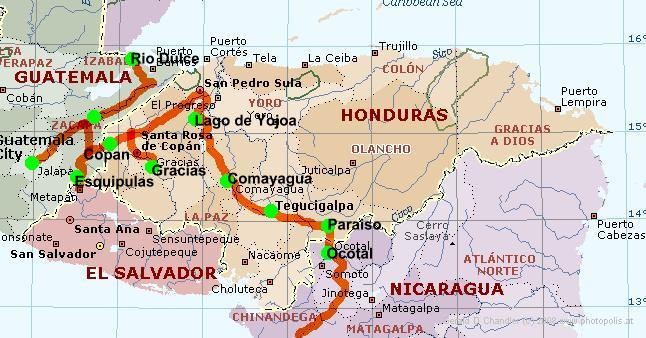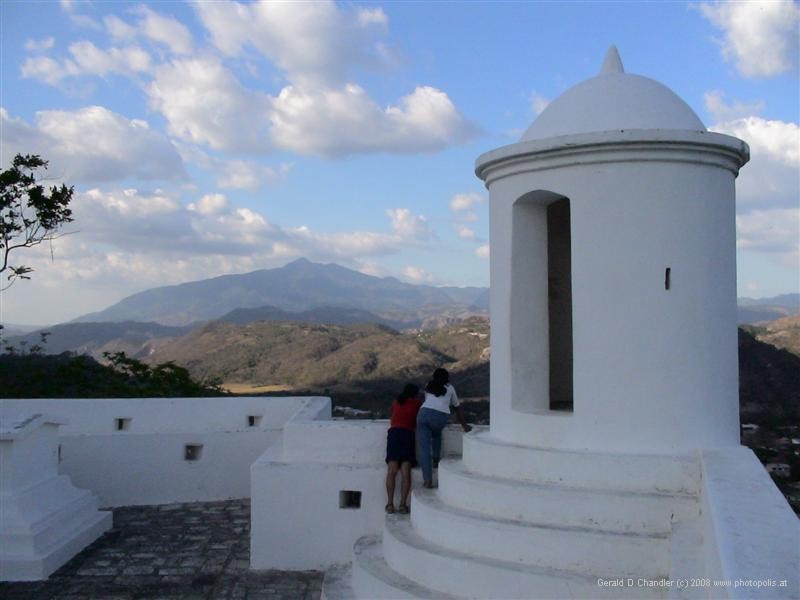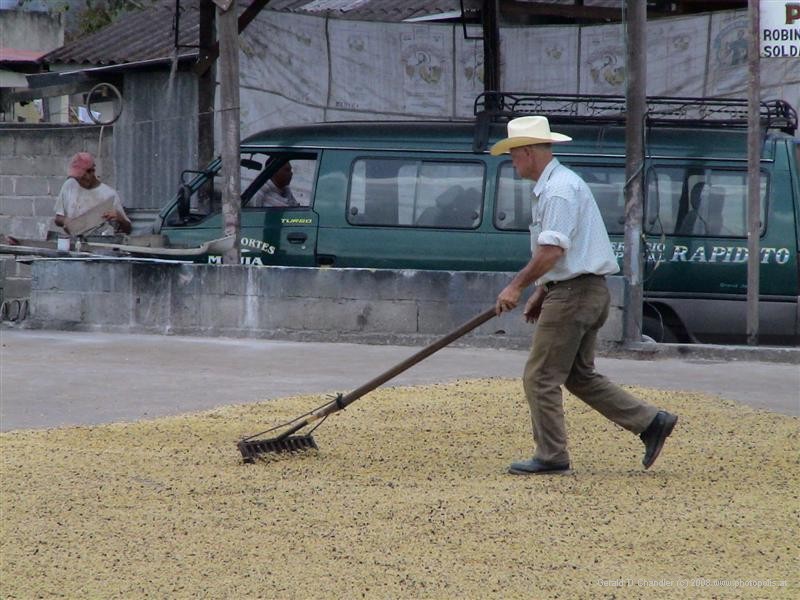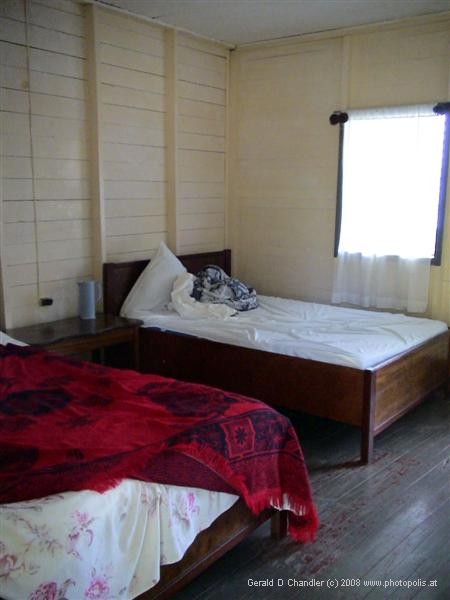Home | Front Page | Index | Blog | New | Contact | Site Map
Copan Mayans
Copan Ruinas
Gracias
Lago Yojoa
Comayagua
Tegucigalpa
People
Volunteers
Foto Show

Route Maps
Belize
Guatemala
Nicaragua
Costa Rica
Panama

Countryside between Honduran Border and Copan Ruinas |
When we entered Honduras we had only two musts on our agenda: see the Mayan ruins at Copan and exit at the other side of the country into Nicaragua. We accomplished both and had a nice, relaxed time in between.
As usual, the border crossing was pretty easy. Maybe we aren't too demanding, since we think a few hours and a few dollars are quite reasonable. Once away from the border we were treated to a beautiful winding mountain road that quickly ascended and then slowly descended the fifteen or so kilometers to the town of Copan Ruinas.

Honduras Route |
Our first full day we walked the kilometer from Copan Ruinas (town) to Copan (Mayan Site). It turned out to be easy: just follow the sidewalk (no kidding) from town into countryside and then cross the street. But at first we couldn't believe it. The site far surpassed our expectations. It is famous for stelae and it had plenty of them and they were magnificent. And beside, unexpected by us (we should have read more?), there were enough temples and ruins and jungle-like trees to make it a famous place even without the stelae. And, bonus, at the entrance there were a dozen or so semi-tame Scarlet Macaws that fascinated us. The feeling was not mutual. One of them attacked Gerry as he was trying to get a photo of them. It nipped at his ankles, fortunately not enountering anything but his leather boot.

Mayan Scuplture at Copan, Honduras |
Besides the famous Copan site there is another associated site, Las Sepulturas, and two museums all worthy of visits. Our second day we walked out to the modern museum adjacent to the main Mayan ruins and it blew us away. It is one large, boxy building, with an open center that contains an entire life-size replica of a temple that had been buried under a newer temple for a thousand years. Around the central courtyard, on two levels, are many pieces of stone work — magnificent pieces — that were excavated at Copan and Las Sepulturas. Among them are the originals of many stelae; copies have often been placed at the original sites so that the originals are not damaged any further by vandalism, thieves, or weather. The next day, our third, we walked out past Copan and its museum another kilometer to the entrance to Las Sepulturas. There we were happily surprised by the extent of this site where the powerful and mighty of Copan used to live. In the afternoon we visted the older, in-town museum and were suprised that, although small, the quality of its objects nearly equaled that of the newer museum.
We decided next to head for the mountain town of Gracias, where we expected to find pleasant weather and a charming old colonial city. Our route took us north-east to La Entrada before we could turn south-east to Gracias. Near and just before La Entrada is Parque Arqueologico El Puente, a minor Mayan site. We enjoyed a half-day there, climbing to the top of its one pyramid and seeing its museum before going off to an unsatisfactory lunch at a Chinese restaurant on the edge of La Entrada. After that we drove south-east through pleasant, slowly rising hills almost to Santa Rosa before we turned off for Gracias. From that point the road rose over a high watershed and then descended and descended in continuing curves that gave wonderful views of the beautiful countryside.

Castillo San Cristobal, Gracias, Honduras |
Gracias was nice but did not live up to our expectations. By comparison to Antigua or even Copan Ruinas it was deserted of tourists. The two old churches are nice but not remarkable, although a building next to one goes back to almost the beginning of Spanish rule. Gracias is one of the setting off points for hikes into the nearby Parque Nacional Celaque. We skipped that because the roads in were worse than we wanted to attempt and without our car we would have to overnight, which we didn't want to do. We did go out of town to the Balneario Aguas Termales; there are three pools, almost swimming pools, fed by natural hot water. On our trip out we were accompanied by an old woman who designated us as her appointed means of transport. The last two kilometers were rough, unpaved road with deep ditches, but we made it.

Raking coffee beans for drying, La Entranda |
Our last day we met some Europeans who had come by bus from La Esperanza, only 60 km away. Their story of a rough ride convinced us to go the long way around, via San Pedro Sula, to Lago de Yojoa (pronounced Joe-HOE-uh). The ride back over the mountains was equally beautiful. We stopped for a short look around the main city of the district, Santa Rosa de Copan, and thought our hour worth it but that a longer stay wasn't warranted. Gerry came away with a new pair of swimming goggles, to replace those lost at Rio Dulce, Guatemala. Then back down to La Entrada where at lunch we met two people from our corner of New Jersey; they were part of a church group of thirty or so who make an annual trip to support a nearby town with schooling and health care.
The drive from La Entrada to the outskirts of San Pedro Sula was down a long valley that descends to the Carribean; it was quite pleasant, but not exciting. As we went we debated changing our minds and going to Omoa, the backpacker beach resort, but decided that it didn't seem to have the facilities we wanted. We skipped San Pedro Sula, too, although it is the Pittsburgh and Manhattan of Honduras; we did get a much too strong whiff of its polluted air, something we had not seen in two or three months.

Our room at Agua Azul Hotel, Lake Yojoa |

One of Bob Dale's Flowers |
With only a little difficulty we found our LP recommended hotel, Agua Azul, right on the shores of Lago de Yojoa. We hesitated because although the site is attractive, especially the open-sided dining room with its fine view of the lake, most of the place was quite run down and our room was not even up to Catskill cabin standards. We ended up there four days, enjoying the quiet, the meals overlooking the lake, and reading a lot on our screened porch, since there was no TV. The porch was assaulted nightly, however, by hordes of black beetles that could be heard during the night hours pinging against the glass louvers of the porch windows trying to get into the light.
One day we went out to nearby Los Naranjos, an archeological site that has almost no archeology for the visitor. It does have nice green grounds on the shore of the lake and we enjoyed that, as well as the whole fish we had for lunch. On the day that we left we drove north to Pulhapanzak Falls, which at 43 m is very impressive, but nowhere near the world-shattering 443 m that LP says it is. We tried to go around the west side of the lake and thus happened on Bob Dale's D&D Bed & Breakfast. He's a drop out from the American rat-race and has built up his place using his own muscles. Then it was on a few hours to Comayagua.
Lots of places in Central America don't have street-address systems. Comayagua must be the worst. It is a small town and we spent an hour trying to find our selected hotel. When we did we didn't like it and then easily found another better for us. The main attraction of Comayagua should have been its colonial remains or even ruins, but there aren't that many. We did like the central square and two old churces we visited, but two others were locked up. The small museum was nice. Why do they have a no-photos policy?
It's only 80 km from Comayagua to Tegucigalpa. On the way we missed the turnoff for La Paz, so we didn't see the ruins near there. And we didn't go to La Esperanza, which has a traditional Indian market. What did we miss? The last part of the drive to Tegucigalpa reveals it as lying in a mountain-surrounded depression; somehow calling it a valley doesn't seem right. We missed the turn-off to go directly to the center and instead circled around, giving us more of a feel for the city.

Central Tegucigalpa
|

National Theatre
|
We like cities; they are of course, the home to culture — and we are culture mavens — so we liked Tegucigalpa (— really Gerry; Jan was more reserved about it). We got to the two nice churches in the center, even though the view of the Cathedral was blocked by work on the adjacent square, and the bigger, suburban Basilica. We saw the gem of a park that has miniature reproductions of Mayan sites and art on our way to the National History museum, which is in the magnificent home of a former president.
Our last day and a half in Honduras were spent getting to the Nicaraguan border. We stopped a little more than half way from Tegucigalpa at Dahli for lunch. We liked the adjoining hotel but they wouldn't accept our offer. So we went off to El Paraiso for the night, which was fortunate, in that we found a very friendly, low priced auto shop where we got a muffler fix that ended our noise headaches for a while. The town itself is small, with a modern center and a few blocks away people living in homes along a small stream with no car access.